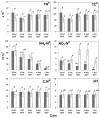Understory Dwarf Bamboo Affects Microbial Community Structures and Soil Properties in a Betula ermanii Forest in Northern Japan
- PMID: 28450660
- PMCID: PMC5478532
- DOI: 10.1264/jsme2.ME16154
Understory Dwarf Bamboo Affects Microbial Community Structures and Soil Properties in a Betula ermanii Forest in Northern Japan
Abstract
In order to understand the relationships between understory bamboo and soil properties, we compared microbial community structures in the soil of a Betula ermanii boreal forest with Sasa kurilensis present and removed using high-throughput DNA sequencing. The presence of understory S. kurilensis strongly affected soil properties, including total carbon, total nitrogen, nitrate, and the C:N ratio as well as relative soil moisture. Marked differences were also noted in fungal and bacterial communities between plots. The relative abundance of the fungal phylum Ascomycota was 13.9% in the Sasa-intact plot and only 0.54% in the Sasa-removed plot. Among the Ascomycota fungi identified, the most prevalent were members of the family Pezizaceae. We found that the abundance of Pezizaceae, known to act as mycorrhizal fungi, was related to the amount of total carbon in the Sasa-intact plot. The relative abundance of Proteobacteria was significantly higher, whereas those of Planctomycetes and Actinobacteria were lower in the Sasa-intact plot than in the Sasa-removed plot. Furthermore, the results obtained suggest that some species of the phylum Planctomycetes are more likely to occur in the presence of S. kurilensis. Collectively, these results indicate that the presence of S. kurilensis affects microbial communities and soil properties in a B. ermanii boreal forest.
Keywords: Sasa kurilensis; bacteria; boreal forest; fungi; high-throughput sequencing.
Figures






Similar articles
-
Variations in bacterial and fungal communities through soil depth profiles in a Betula albosinensis forest.J Microbiol. 2017 Sep;55(9):684-693. doi: 10.1007/s12275-017-6466-8. Epub 2017 Sep 2. J Microbiol. 2017. PMID: 28865070
-
Soil bacterial community structure of mixed bamboo and broad-leaved forest based on tree crown width ratio.Sci Rep. 2020 Apr 16;10(1):6522. doi: 10.1038/s41598-020-63547-x. Sci Rep. 2020. PMID: 32300174 Free PMC article.
-
The soil carbon/nitrogen ratio and moisture affect microbial community structures in alkaline permafrost-affected soils with different vegetation types on the Tibetan plateau.Res Microbiol. 2014 Feb-Mar;165(2):128-39. doi: 10.1016/j.resmic.2014.01.002. Epub 2014 Jan 23. Res Microbiol. 2014. PMID: 24463013
-
Forest Soil Bacteria: Diversity, Involvement in Ecosystem Processes, and Response to Global Change.Microbiol Mol Biol Rev. 2017 Apr 12;81(2):e00063-16. doi: 10.1128/MMBR.00063-16. Print 2017 Jun. Microbiol Mol Biol Rev. 2017. PMID: 28404790 Free PMC article. Review.
-
Application of Bamboo Plants in Nine Aspects.ScientificWorldJournal. 2020 Sep 30;2020:7284203. doi: 10.1155/2020/7284203. eCollection 2020. ScientificWorldJournal. 2020. PMID: 33061861 Free PMC article. Review.
Cited by
-
Ecological clusters of soil taxa within bipartite networks are highly sensitive to climatic conditions in global drylands.Philos Trans R Soc Lond B Biol Sci. 2022 Aug 15;377(1857):20210387. doi: 10.1098/rstb.2021.0387. Epub 2022 Jun 27. Philos Trans R Soc Lond B Biol Sci. 2022. PMID: 35757878 Free PMC article.
References
-
- Baldwin B.G. Phylogenetic utility of the internal transcribed spacers of nuclear ribosomal DNA in plants: an example from the Compositae. Molecular phylogenetics and evolution. 1992;1:3–16. - PubMed
-
- Butler M., Day A. Fungal melanins: a review. Can J Microbiol. 1998;44:1115–1136.
-
- Clemmensen K.E., Bahr A., Ovaskainen O., et al. Roots and associated fungi drive long-term carbon sequestration in boreal forest. Science. 2013;339:1615–1618. - PubMed
MeSH terms
Substances
LinkOut - more resources
Full Text Sources
Other Literature Sources

